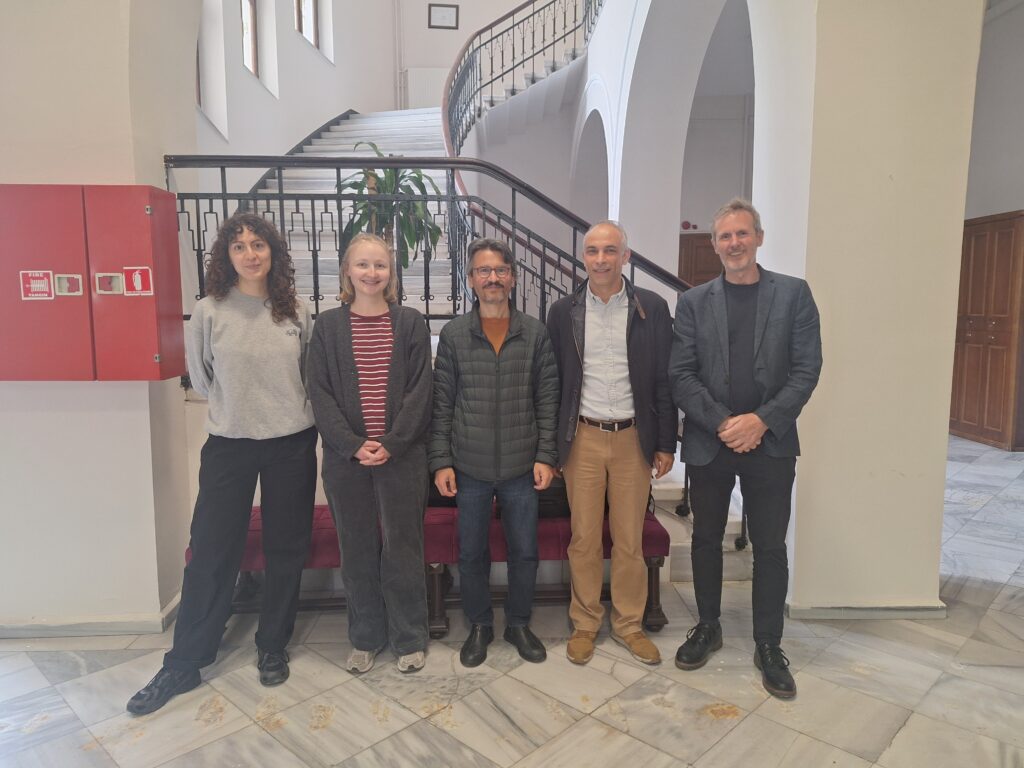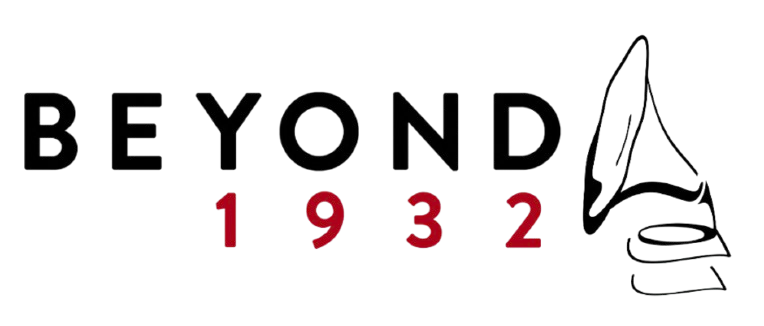
The high point of a week touring various archives and meeting with various colleagues was an afternoon’s workshop organized by Prof Burcu Yıldız at Istanbul Teknik Üniversitesi, where eight groups (including ours) summarized their work and thinking. Despite the constrained nature of academic life in Turkey these days, the gathering showcased – on the Turkish side – extensive work in the late Ottoman and early Republican music and sound archives, and in the archives of key musicians and academics. Our academic colleagues there are working not only tirelessly, but in an impressively collaborative and coordinated fashion (under today’s difficult conditions, which include damage wrought by the recent earthquake) to digitize them and make them publicly accessible.
We heard from Faruk Çalışkan on the (Berker/Beşiroğlu) Istanbul Technical University’s archives, from Nilgün Doğrusöz Dişiaçık on ITÜ’s Ottoman Music Research Group (OTMAG)’s archival work, from Songül Karahasanoğlu and Ersin Mıhcı about the current state of the Corpus Musicae Ottomanicae project, from Ozan Baysal about ‘Makamnetz’, from Mehtap Demir Güven and Ulaş Özdemir about the Darülelhan collection, from Onur Güneş Ayas about the Dileklerarası project at Yıldız Technical University, and from Sungu Okan, who put a brave face on being the last presenter in an information-packed afternoon, about her team’s work at Mimar Sinan on the Cemal Reşit Rey archive.
Earlier in the week Ulaş Özdemir invited us to visit the Nadir Eserler archives at Istanbul University. The fabled sound archives are now housed where they originated, in the ‘Darülelhan’, the Ottoman music Conservatoire that continued functioning in the early Republic as the ‘Belediye’ Conservatoire, and which organized fieldtrips in various parts of Anatolia to collect (i.e. transcribe and later record) folksongs. The collection is extraordinarily valuable not just for the quantity and quality of the recordings but for the fact that the original master discs are still intact. It has had a checkered history, with various parties over the last half century competing to house and curate them (as we might say now – i.e. to make them available to broader publics, to perform their repertoires, to publish scholarly work on them).
One has to remember that the material remains of Ottoman culture were hazy and ambiguous objects in the 1980s, a period inaugurated by the 11 September 1980 coup, during which people preferred not to look back. ‘The archive’ was, by definition, closed, or, at least, kept in dusty rooms under lock and key. Things have changed greatly. The 600 or so recordings have ended up being well-looked after in a designated room in the original Darülelhan building in Istanbul University – a beautiful home for it. The complex and slow job of cataloguing is underway. We enjoyed spending a morning listening to original recordings. How very present these musicians – and those recording them – felt, listening to these discs in this room. The group photo we took in the entrance hall felt especially meaningful. It is, after all, a parallel world, and one closely related, to the 1932 Cairo Congress.
On our penultimate day, we visited Üsküdar, where we were the guests of Dr. Harun Korkmaz and his team at ISAM (Islam Araștırmaları Merkezi). This group is looking after the Cüneyt Kosal archive, a huge collection of notations and manuscripts assembled by an individual who moved between the worlds of mysticism (specifically, Mevlevi) and the state (as a highly respected kanun player at Turkish Radio and Television). Kosal passed away in 2018. We think of the scholar in the archive labouring alone in a silent and dusty space. Well, there was certainly plenty of dust. But this was also an exuberant scene of collaborative discussion, brainstorming, erudite chit-chat and full volume singing (!). Here is another way of being in the archive – one which will be familiar to anybody who knows the irrepressible Harun Korkmaz, one of the leading Ottoman classical music vocalists in the city.
An unidentified manuscript his team had found hard to decipher – Arabic, and written in western notation, but evidently before the advent of methods of representing maqam tonalities, and strangely annotated by a second hand, and which seems to have come into Kosal’s possession via Ali Rıfat (Çağatay) – turns out quite likely to be a notation of Tunisian ma’luf (Nawba Rast-i Dil) – and probably from around about the turn of the century. The MS is possibly important; our friends in Paris, to be pursued by Farid Ghrich, will no doubt tell us more.
Later in the afternoon, we discussed the 1932 Cairo Mevlevi recording, recording material for one of Farid’s project podcasts. Conversation moved swiftly and unexpectedly, as it often does when we share our listening. We wondered about the links between Lachmann’s recordings and a western music notated version of the Köçek Derviş Mustafa Dede Beyati Ayin and a hand-written musical notation Harun had picked up by chance from a second hand bookseller in Istanbul, evidently from the Aleppo Mevlevihane, dating from somewhat later, possibly in the hand of, or authorized by, Hasan Dede (1890-1973). Hasan Dede began his Mevlevi career in Izmir, took his çile (ritual retreat) in Aleppo, assumed his status as Dede in Konya, and then moved back to Aleppo at chief neyzen. This ayin is a kind of ‘national anthem’ for Mevlevi-s, as Harun pointed out. So we could learn important things about how canonical items of repertoire circulated around the Ottoman Arab periphery at the time. So the evening continued…
There is a great deal to reflect on here, about how archives ‘work’, about the strange alchemy of the objects that reside in them, about the scholarly – and vocal, and sonic – life they animate, which seems, quite often, to find a way of dancing free of academic bureaucracies and institutional politics. This is due, in no small measure, to the industry and energy of our wonderful Turkish colleagues. But much has changed since the 1980s, when archives were difficult to access, and those seeking such access were automatically regarded with suspicion. And since the early 2000s, too, when attitudes might have changed, and the past was no longer a foreign country, but things were still pretty chaotic.
I spent a morning on this visit (after my colleagues had left) in the Atatürk Kitaplığı in Taksim – a great archive for early Republican era print journalism, amongst other things. I had not been here before. The first words I heard at the door – as I handed over my passport – were, themselves, significant: “hoş geldiniz”, “welcome”! I had a librarian to myself, who helped me locate some useful sources, who instilled a bit of realism about what I could and couldn’t achieve in the time available and helped me shortcut the (relatively benign) logging-on and registration process. The newspapers would take 20 minutes, he said. Until then, why not have a tea in the café? Which I did. The tea was free, the Bosphorus shone blue through the window, and a bunch of newspapers was waiting for me on my return.
Things have become vastly, vastly easier with digitization and the wonders of modern information architectures in archives like these. And in a State that now (claims to) value the past, rather than fear it. All of this, obviously enough, makes it easier for the State to keep an eye on those who use them. But the past is more than the surveying of documents, and the surveillance of those who survey. This came up recently in conversation with Ziad Fahmy, who strongly recommended I read Alan Mikhail’s recent My Egypt Archive. I will do as soon as I possibly can. It seems entirely relevant. As often, from an outsider’s perspective, Turkey and Egypt contrast, but share much, variously at or below the surface… The Istanbul week has, however, most certainly been a week to reflect on concerning archives as a site of sociability, hospitality and sharing. Deep thanks to everybody mentioned here.

